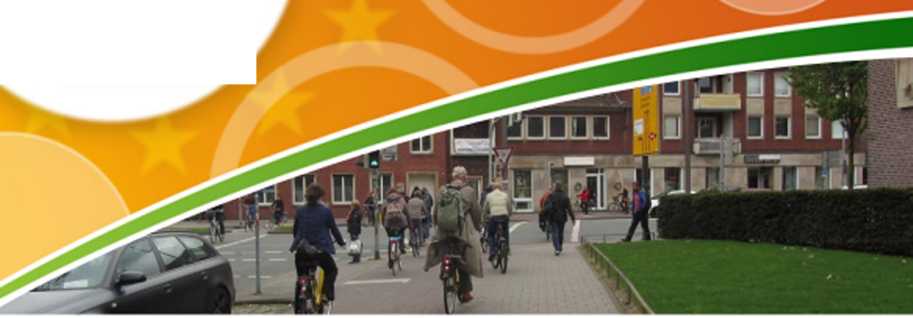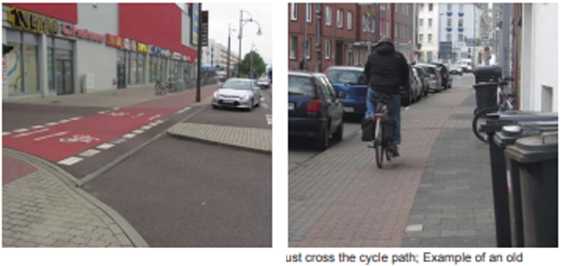9220598007

SCMbtice/
Central MeetBike A
Fact Sheet
H-03 - Cycling Facilities off the Road
Application of cycle paths
Deciding on the appropriate type ot cycle facility in urban areas is a com-plex process involving the careful con-sideration of criteria such as motor vehide volumes. proportion of heavy goods vehides. speed of motor vehic-les and Street gradient, among others. The main fadors influencing the dedsi-on to implement a physically separated cycle track alongside the carriageway are available space. motor vehide speed and car volume. In generał cy-clists should be physically separated from motorised traffic in streets where vehide speeds exceed 50 km/h. For morę information on choosing the appropriate form of cycle provision see Fad Sheet H-02 and the speed-volume diagram in the Central MeetBike strate-gy recommendations [Ahrens/Schubert (2014). p.48].
Intersedions and other crossings re-present conflid points between cyclists and drivers. The number of intersec-tions (including property access roads or driveways) and their frequency ot use are therefore also important fac-tors influendng the decision to use off-carriageway cyde paths. Cyde paths are generally appropriate for road seg-ments with few interruptions [Deffner et al. (2012). p.78]. Because cyde paths are often separated from the carriageway through a row of parked cars or a planted area it is especially important to ensure a high level of visibility at in-tersections (see Fact Sheet H-04). As such. for road segments with a rela-tively high number of intersedions or crossings it ts recommended that cycle provision be provided on the carriageway in order to maintain good visibility between cyclists and (in parlicular tur-ning) drwers (see Fad Sheet H-02).
Types of cycle paths
Cycle paths are physically separated from the carriageway through a kerb. parking lane or planted area. In generał there are three main categories of cyde paths: dedicated cycle tracks. shared use sidewalks and greenways.
Dedicated cyde tracks run parallel to the carriageway and are for the exdusi-ve use of cydists. Their use may be ob-ligatory. indicated using a posted sign and/or pavement markings. as long as they meet current standards of safe-ty and quality. The standard width for one-way cycle tracks is 2.00 m. which allows also cydists to overtake slower bicycles. According to German guide-lines. larger widths may be necessary for:
• Segments which are main routes within the bicyde network
• High volumes of cydists in order to achieve an appropriate level of service and comfort level
• Frequent peaks in demand (groups of cydists)
• Moderate to high activity in adjacent pedestrian areas
• Steep declines
Two-way cyde tracks may be used in exceptional cases and after careful consideration. The standard width in German guidelines for a two-way cycle track on one side of the Street

Examp(e ot a good sol utoń (lefl). nrfiere vehides lashoned cyde palh (right) • the psth is too narrow and there is no space fbc pedeslnans (source: Jan Schubert)

Wyszukiwarka
Podobne podstrony:
Fact Sheet H-02 - Cycling Facilities on the RoadOverview Street space is a limited resource. The pro
CMbii^Central MeetBikelFact Sheet H-06 - Rural Cycling (daily and leisure routes) Necessity of rural
ZmbiH Central MeetBike AFact Sheet H-08 - Bicycle Parking Facilities Introduction Ouality bicycle pa
FactSheetT-01 -Incorporate Cycling into City Administration Introduction In Central MeetBike it beca
Fact Sheet T-03 - Options for financing measures for Cycling Introduction building 300 m of a cyde
CENTRALNE LABORATORIUM OCHRONY RADIOLOGICZNEJ 03-194 Warszawa, ul. Konwaliowa 7 tel.: 22 8111616
Ćw. nr 3 - Usługi centrali abonenckiej DGT 2014-03-26 Ćw. nr 3 - Usługi centrali abonenckiej DGT
Ćw. nr 3 - Usługi centrali abonenckiej DGT 2014-03-26 4. Usługi telekomunikacyjne w sieciach publicz
Ćw. nr 3 ~ Usługi centrali abonenckiej DGT 2014-03-26 Rys. 4a Usługi przenoszenia i teleuslugi Do ty
Ćw. nr 3 ~ Usługi centrali abonenckiej DGT 2014-03-26 teiekomenda - zdalne sterowanie urządzeniami
Ćw. nr 3 ~ Usługi centrali abonenckiej DGT 2014-03-26 Zamówianie, usługi dodatkowej jest możliwe z k
Ćw. nr 3 ~ Usługi centrali abonenckiej DGT 2014-03-26 UWAGA! Dla pewnych usług rejestracja jest jedn
Ćw. nr 3 - Usługi centrali abonenckiej DGT 2014-03-26 4.3 Spis usług dodatkowych centrali DGT
Ćw. nr 3 - Usługi centrali abonenckiej DGT 2014-03-26 złośliwych (MCID) odkładaj mikrotelefonu
Ćw. nr 3 ~ Usługi centrali abonenckiej DGT 2014-03-26 5. Opis usług dodatkowych Opis powstał na pods
Ćw. nr 3 ~ Usługi centrali abonenckiej DGT 2014-03-26 zaprogramowanego numeru telefonicznego. Można
Ćw. nr 3 ~ Usługi centrali abonenckiej DGT 2014-03-26 1. Cel i zakres ćwiczenia Ce
Ćw. nr 3 ~ Usługi centrali abonenckiej DGT 2014-03-26 Abonent z aktywną usługą - po podniesieniu
Ćw. nr 3 ~ Usługi centrali abonenckiej DGT 2014-03-26 zapoczątkowana w latach osiemdziesiątych XX wi
więcej podobnych podstron